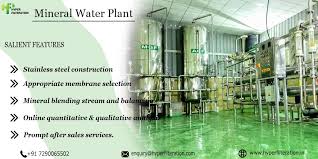Introduction
Water is one of Earth’s most precious resources, sustaining life, supporting ecosystems, and driving economic activities. With increasing industrialization, urban growth, and climate change, the demand for clean, accessible water has never been more crucial. Ensuring water quality for drinking, agricultural, and industrial use while protecting the environment is a complex challenge addressed by water treatment plant (WTP). These facilities treat water from various sources, removing impurities and contaminants to provide safe, reliable water for communities. This article explores the fundamental functions, stages, challenges, and future trends of water treatment plant, underscoring its essential role in public health, environmental conservation, and sustainability.
The Purpose and Importance of Water Treatment Plant
Water treatment plant serves two main purposes: ensuring that water is safe for human consumption and protecting natural water bodies by treating wastewater before it is discharged back into the environment. As populations grow and urban areas expand, the demand for potable water increases, putting strain on freshwater sources. Additionally, with the rise of industrial activities and the introduction of new contaminants, traditional water sources are increasingly at risk of pollution. Water treatment plant has thus become essential in:
- Protecting Public Health: Clean, pathogen-free drinking water is essential for preventing waterborne diseases like cholera, dysentery, and typhoid. By removing harmful contaminants, WTP plays a critical role in safeguarding public health.
- Environmental Preservation: Discharging untreated or partially treated wastewater into rivers, lakes, and oceans can harm aquatic ecosystems, disrupt biodiversity, and contaminate drinking water sources. WTP helps mitigate these effects, ensuring that discharged water meets environmental standards and supports aquatic life.
- Supporting Industry and Agriculture: Many industrial processes and agricultural activities require clean water for safe and efficient operations. WTP provides treated water for industries such as food production, pharmaceuticals, and agriculture, where water quality directly impacts production outcomes.
Key Processes in Water Treatment
Water treatment plant typically uses a series of steps to purify water, each designed to remove specific types of contaminants. Here are the primary stages:
- Coagulation and Flocculation: In this initial stage, chemicals like alum are added to the water to create positive charges that bind with negatively charged particles. This process forms larger clumps, or flocs, which can be easily removed. Coagulation and flocculation are particularly effective for removing suspended particles, organic matter, and certain types of pathogens.
- Sedimentation: During sedimentation, the water flows into large tanks, where gravity allows the heavier particles to settle at the bottom. This process removes solids from the water, which are then collected as sludge for further treatment.
- Filtration: After sedimentation, the water is filtered through sand, gravel, or membrane filters to remove finer particles and impurities. Filtration also removes certain pathogens and organic materials, providing an additional level of purification.
- Disinfection: The final stage in most water treatment processes is disinfection, where chemicals like chlorine or processes like ultraviolet (UV) light are used to kill any remaining microorganisms. This ensures the water is free from bacteria, viruses, and other pathogens.
- Distribution: After treatment, the purified water is distributed to homes, industries, and agricultural areas. In many cases, water treatment plant also monitors the water quality at various points along the distribution network to ensure that it meets regulatory standards.
Types of Water Treatment Plant
Depending on the water source and treatment needs, water treatment plant can be classified into several categories:
- Drinking Water Treatment Plant: This plant focuses on purifying water for safe human consumption, ensuring it meets health and safety standards for drinking water. It treats water from rivers, lakes, reservoirs, or underground aquifers.
- Wastewater Treatment Plant: This facility treats sewage and industrial wastewater to remove contaminants before it is discharged into the environment. It focuses on removing organic matter, nutrients, and other pollutants to protect aquatic ecosystems.
- Desalination Plant: In regions with limited freshwater sources, desalination plant provides an alternative by removing salt and other impurities from seawater. While effective, desalination is energy-intensive and costly, so it’s generally used in areas facing severe water scarcity.
- Industrial Water Treatment Plant: This plant serves industries requiring specific water quality standards for production processes. Examples include the pharmaceutical, food, and beverage sectors, where water purity is crucial.
Technological Innovations in Water Treatment
Water treatment technology has evolved significantly in recent years, driven by the need for improved efficiency, sustainability, and the ability to handle complex contaminants. Some of the leading technologies include:
- Membrane Filtration: Technologies like ultrafiltration, nanofiltration, and reverse osmosis use semi-permeable membranes to remove microscopic particles and dissolved substances. Membrane filtration is highly effective in removing salts, bacteria, and certain chemical contaminants.
- Advanced Oxidation Processes (AOPs): AOPs involve the use of powerful oxidants, such as ozone, hydrogen peroxide, and UV light, to break down complex organic compounds that are difficult to remove with conventional methods. These processes are particularly useful for treating industrial wastewater containing persistent pollutants.
- Biological Treatment: Biological processes, including aerobic and anaerobic treatments, use microorganisms to degrade organic matter in wastewater. These methods are commonly used in municipal waste water treatment plant to reduce biochemical oxygen demand (BOD) and nutrient loads.
- Artificial Intelligence and Data Analytics: Many modern treatment plant are incorporating AI and data analytics to optimize operations, predict maintenance needs, and monitor water quality in real time. This enables facilities to operate more efficiently and respond to changes in water quality more effectively.
- Resource Recovery: Some treatment plant are designed to recover resources, such as energy, nutrients, and biogas, from wastewater. Anaerobic digestion, for instance, can produce biogas that powers plant operations, reducing dependency on external energy sources.
Challenges Facing Water Treatment Plant
Despite technological advancements, water treatment plant face several challenges that impact their ability to operate efficiently and sustainably.
- Increasing Demand for Water: As populations grow and urbanize, demand for clean water continues to rise. Many existing treatment plant operate at or near capacity, making it challenging to meet water needs without expansion or upgrades.
- Emerging Contaminants: New pollutants, such as pharmaceuticals, personal care products, and microplastics, are entering water supplies and challenging traditional treatment methods. Many treatment plant are not designed to remove these contaminants, requiring the development of new treatment techniques.
- Aging Infrastructure: In many regions, water treatment infrastructure is outdated, leading to inefficiencies, maintenance issues, and increased risk of service interruptions. Upgrading these facilities is costly but essential for reliable and sustainable water treatment.
- Energy Consumption: Water treatment is an energy-intensive process, with operations like aeration and pumping consuming significant amounts of power. High energy costs and a reliance on fossil fuels contribute to the environmental footprint of treatment plant.
- Sludge Management: Sludge disposal is a critical environmental and operational challenge, as the byproducts of water treatment often contain pollutants that require careful handling and disposal. Some facilities are exploring sludge-to-energy solutions and sludge recycling to reduce disposal issues.
Environmental and Economic Impacts of Water Treatment Plant
Water treatment plant provide substantial environmental and economic benefits but also have associated costs and environmental impacts. Understanding these impacts can guide efforts to improve the sustainability of treatment facilities.
- Environmental Benefits:
- Pollution Reduction: Water treatment plant reduce pollution in natural water bodies by removing contaminants from wastewater, helping to protect aquatic ecosystems and biodiversity.
- Water Conservation: By treating and reusing wastewater, treatment plant help conserve freshwater resources and alleviate pressure on overused sources.
- Climate Change Mitigation: Some treatment facilities are exploring renewable energy sources, such as solar and biogas, to reduce greenhouse gas emissions associated with energy-intensive treatment processes.
- Economic Impact:
- Job Creation: The construction, operation, and maintenance of water treatment facilities provide employment opportunities, contributing to local economies.
- Industrial Productivity: Clean water supports various industries, enhancing productivity and ensuring the safety of products, especially in sectors like food and pharmaceuticals.
- Cost Savings: Effective water treatment reduces healthcare costs associated with waterborne diseases, as well as the costs of environmental degradation.
- Challenges to Sustainability:
- Resource Consumption: Water treatment consumes energy, chemicals, and other resources, contributing to its environmental footprint. Efforts to improve energy efficiency and reduce chemical use are critical to enhancing sustainability.
- Waste Generation: Sludge and other byproducts require proper disposal, and untreated sludge can pose risks to soil and water quality if not managed responsibly.
Future Trends and Innovations in Water Treatment
The water treatment industry is evolving to address current challenges and adapt to changing environmental conditions. Several trends and innovations are shaping the future of water treatment:
- Decentralized Treatment Systems: Decentralized systems treat water closer to the source, reducing the need for extensive distribution networks and providing flexibility for rural and remote areas. These systems can be more resilient, especially in areas vulnerable to climate change impacts.
- Integrated Water Management: Some water treatment plant are moving toward integrated water management, which considers water supply, wastewater treatment, stormwater management, and resource recovery as part of a unified system. This approach can help optimize water use and reduce waste.
- Circular Economy in Water Treatment: Adopting circular economy principles, water treatment plant are finding ways to recycle and reuse water and resources, such as energy and nutrients. This reduces waste generation and enhances the economic viability of water treatment operations.
- Nanotechnology: Nanomaterials, such as nanofibers and nanotubes, have shown promise in water treatment for removing pollutants, heavy metals, and pathogens more effectively than traditional methods.
- Public Awareness and Participation: Many facilities are increasing public awareness of water conservation and pollution prevention. Educating communities about responsible water use and encouraging water-saving behaviors help reduce the burden on treatment facilities and contribute to sustainable water management.
Conclusion
Water treatment plant are indispensable in today’s world, playing a critical role in providing clean water, supporting public health, and protecting ecosystems. As urbanization, industrialization, and climate change continue to impact water resources, the need for efficient, resilient, and sustainable water treatment systems will only grow. Advances in technology, such as membrane filtration, advanced oxidation processes, and AI, offer promising pathways to address emerging contaminants, reduce energy consumption, and enhance operational efficiency.
While challenges remain, including the need for infrastructure investment, sludge management, and chemical use, ongoing innovation and a commitment to sustainability are paving the way for the water treatment plant of the future. Through continued investment in technology and sustainable practices, these facilities will remain at the forefront of efforts to secure clean, safe, and accessible water for generations to come.




